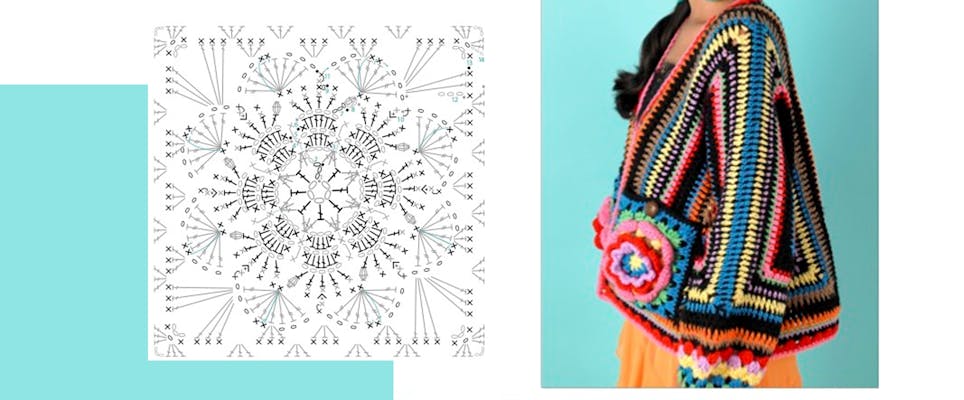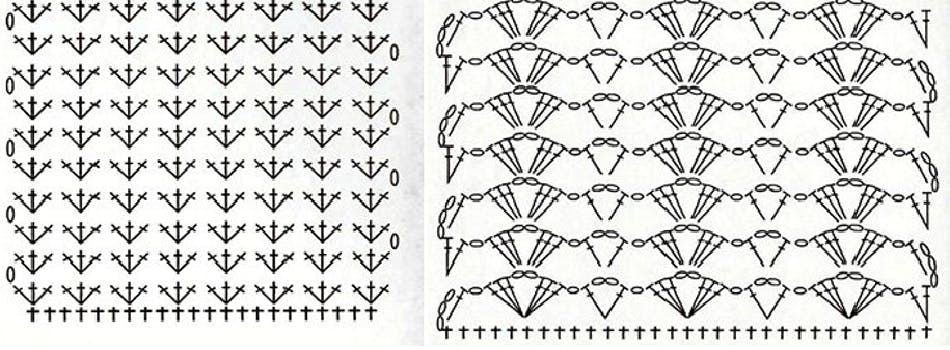How to read crochet charts
Published on 1 February 2022 6 min read
Want to learn how to read your favourite crochet patterns? Look no further! This guide by Mary Beth Temple, aka Hooked for Life, will teach you how to read crochet symbol charts so those little lines will stump you no longer! What are you waiting for?
There are several differences between knit and crochet – not just in the look of the fabric, or in the technical skills needed to make it, but in the way the written patterns work as well. Let’s face it, crochet patterns can be LONG! Not only does the designer have to tell you which stitch to work but also where to put it, and all that instruction can get a little wordy.
More and more designers and publishers are providing crocheters with symbol diagrams to help speed things along. Symbol diagrams give you a visual representation of what your finished stitch is going to look like. In crochet, especially, that picture can be worth a thousand words.
Interpreting symbol diagrams can be a little intimidating though. So, while this guide will show you some of the more common symbols in both UK and US terms, it will also tell you a bit about how to interpret the symbols even if you don’t have the correct key – or are reading from a crochet book in another language like Russian or Japanese. Once you get the hang of how the symbols work, you will never meet a charted stitch you cannot do!
Chain and Slip Stitch

These two are easy, and are the same in both UK and US terminology. Note already that the symbols look exactly like what you are trying to achieve – the chain looks like an elongated loop, and the slip stitch is practically invisible.
Double Crochet

These two – a small X and a small + sign – are interchangeable, and they both mean double crochet (dc) in the UK and single crochet (sc) in the US. Diagrams will have one or the other, but not both in the same diagram.
Half Treble Crochet

This one is a half treble crochet (htr) in the UK and a half double crochet (hdc) in the US. While I have the symbols nice and large here for you to look at, on a fancier pattern in a smaller font, this one can sometimes be mixed up with the + sign above, which is why I think a lot of diagrams are moving towards the X.
Treble Crochet

Here’s where things get interesting. This one has one crossbar, and stands for a treble crochet (tr) in the UK and a double crochet (dc) in the US. This crossbar angles from top left to bottom right, but sometimes you will see it angled the other way (bottom left to top right) or straight across and not angled at all. The crossbars represent yarn overs at the beginning of the stitch, so no matter what you call this stitch – treble, double, Bob, whatever – you know you have one yarn over to make at the start.
Double Treble Crochet

So this one with 2 crossbars is a double treble (dtr) in the UK and a triple or treble (tr) in the US. Notice it’s a little taller than the symbol above – because the stitch would be taller as well.
Triple Treble Crochet

And this one with 3 crossbars and a bit more height is a triple treble (trtr) in the UK, and a double triple or double treble in the US (dtr).
And so on – if I had some wonky tall stitch with 6 crossbars, it wouldn’t matter what it was called, I would just know to begin with 6 yarn overs.
I won’t be able to show you every crochet symbol in the world in one blog post, but remember my goal here is for you to be able to intuit what they mean by looking at them, so I want to show you a couple of decreases, increases or shells, and puffs vs. bobbles.
Double and Treble Crochet Decreases

Decreases are easy to get the hang of – the base of each stitch is in a stitch or space below, so you can count the number of stitches that feed into one and know if you are working 2 together, 3 together, 4 together, etc. The only tricky bit is that the double crochet and treble crochet decreases (single crochet and double crochet in the US) look a bit similar because of where the crossbar on that X or + symbol lands. You can tell them apart by height, and because the taller one usually has a crossbar on the very top.
Increases or Shells (5 Double Crochet Increase)

For increases or shells, the diagram is going to tell me how many of what kind of stitch goes into a single space or stitch below. Here is a diagram of a 5-tr (5-dc in the US) shell, but your diagram can have any number of stitches in it for an increase, or any combination of stitches and chains for a shell.
Puff Stitch & Bobbles

How can you tell a puff stitch from a bobble? Both have multiple stitches coming out of one stitch or space below and have a single crossbar on the top to let you know you have created one stitch. But the puff stitches have no crossbars on the individual stitches because you are picking up yarn overs, not making partial stitches; and the bobbles have crossbars – as many as you need for the height stitch you are working – because you ARE making partial stitches for bobbles! The puff stitch is on the left, below, and the bobble is on the right. Both of these are 3-stitch puffs or bobbles, but of course there could be any number of stitches contributing to the specific puff or bobble in your pattern.
Crochet symbols in practice!

Here are two symbol diagrams I nicked from a pattern of mine, which is also shown below. The stitch pattern with the 3- dc shells (3-sc shells in US terms) is used on the bodice, and the stitch pattern with the shells and chain-spaces is used on the skirt/lower half of the vest. You’ll note that the shell stitch pattern diagram is oriented the way you will see it while you are stitching, not the way it is worn, so it’s easy to compare your work-in-progress to the diagram.
The top image is taken from Paintbox Yarns' Blooming Bomber Jacket.